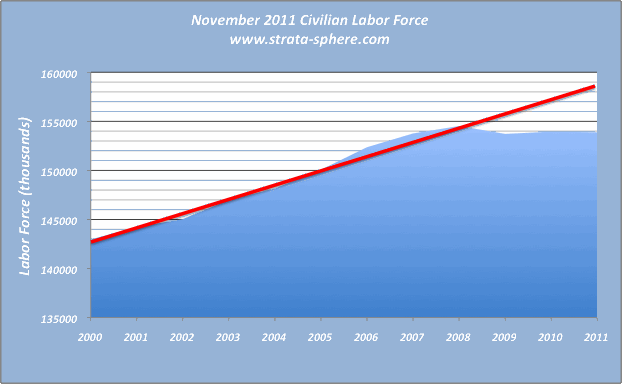Dec 02 2011
Actual Unemployment Closer To 11%
Update: Hot Air notes someone else did another calculation – 11% – end update
One thing this recession has taught a lot of us is the fact that some federal statistics simply suck. Take the unemployment rate. People honestly think this is the number of people who want a job and don’t have one. But it is not.
The unemployment rate is computed from the “civilian workforce” – which is not the total available workforce. I used to think it was until I started plotting where the work force should be given a steady rate of population growth. Since our population has been on a very stable trend for decades, it is obvious that the total available workforce remains a study fraction of the overall population (subtracting out kids,, retired folks, criminals in jail and those with disabilities that preclude being able to hold a job).
Realizing population trends don’t shift very much over such short periods as a decade, I gathered and plotted the civilian workforce numbers for each month of the year and something startling showed up [click to enlarge]:
The blue area is the size of the civilian workforce for the month of November running from November 2000 to November 2011. Note how this workforce grew in size with the population for most of the last decade. In fact, the ‘labor force participation rate’ fluctuated between 66-67% all the way through until the Great Recession hit in 2008. Since then it has dropped (thanks to impotent liberal stimulus policies) to 64% and has never rebounded.
The problem with the unemployment rate touted in the news is it is based on the current workforce size – not what that size should be under normal economic times given our population size.
The red line I added to the chart above shows where we as a nation would have been in terms of ‘civilian workforce’ numbers if we had not hit the 2008 economic down turn. Instead of the current work force in November 2011 of 153,883,000 we should have a workforce of 158,500,000. That is 461,700 viable workers not counted in the November unemployment rate. These people are out there in the population – since our population has not shrunk at all in the last 3 years.
When you recompute the unemployment rate using the number of employed (140,580,000) out of the real workforce of 158,500,000, you get a more accurate reflection of the job situation in America.
That actual unemployment rate is 11.3%
A couple of points on why this is valid and more accurate than the federal computation.
- The available/interested workforce out of any population is pretty stable. Under low unemployment and rising incomes there is a demand for workers that is not met by the workforce. This is why wages rise, etc – supply and demand. When demand outstrips supply there is competition, and therefore the workforce is at its peak capacity. Therefore, the low unemployment period at the beginning of this century reflects the peak participation rate for our society right now – 66-67%
- The unemployment numbers from the government are from surveys. They have limited accuracy (like any poll does). It is highly doubtful they are good to within 100,000 people, so these kinds of estimates are well within the bounds of the government produced numbers. Whether it is 10.9% or 11.5% does not matter, because it definitely is NOT 8.6%!
- This shrinking of the workforce size is seen in all the months of the year to some degree or other, so it is a well documented and real phenomena.
This is why the rosy numbers mean nothing in the real world. The inability to find a good job, build a career, be upwardly mobile is not there. As long as people are not counted in the workforce size, the government’s unemployment numbers will be drastically underestimating the economic suffering in the nation.






Where Are America’s Workers Going? Off the Books.
You’ll recall yesterday I spotlighted an interesting phrase and assessment from CNBC’s Jim Cramer: That for the first time in American history (or at least recent memory), the country is developing a sizable and significant “off-the-books” economy.
Obviously, it’s hard to quantify a phenomenon that is set up to not be measured, but it appears the Great Recession has greatly accelerated this trend, which isn’t good for employees, isn’t good for tax revenues, isn’t good for the rule of law, and probably is not, in the long-term, good for employers. (Wouldn’t an employer rather have happy, loyal, on-the-books employees?)